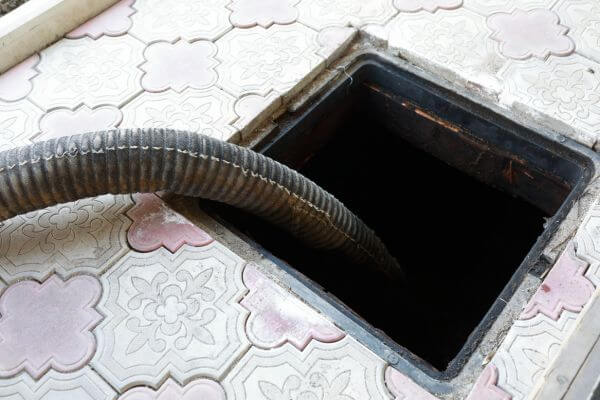The path of water in a septic tank
The operation of a septic tank is designed to treat wastewater efficiently. The water passes through several stages within the system before being returned to the environment.
Initial separation
When wastewater enters the septic tank, an initial physical separation takes place. The heavier solids settle to the bottom, forming sludge, while fats, oils and grease float to the surface, forming a layer known as the cream. The intermediate liquid, which contains the least amount of waste, is the one that moves further in the process.
In-pit treatment
Inside the pit, anaerobic bacteria decompose the organic materials present in the sludge and the liquid. This decomposition process reduces the pollutant load of the water, preparing it for the next stage.
The importance of regular emptying
Over time, accumulated sludge and cream can overwhelm the capacity of the septic tank, making it difficult to operate and increasing the risk of overflows or contamination. To avoid these problems, regular professional emptying is essential.
At Limpiezas Domingo, we take care of extracting the accumulated sludge and debris with specialised equipment, ensuring that your system works optimally.
Output of treated water
The treated liquid, also known as effluent, leaves the pit through a pipe that directs it to an additional treatment or disposal system. This is where the water receives its final treatment before being released into the environment.
Fates of water after the septic tank
The destination of treated water depends on the design of the individual septic tank system and local regulations. Below, we explore the most common destinations of the effluent.
1. Infiltration field or drainage system
The infiltration field is the most common destination for treated water. It consists of a series of perforated pipes that distribute the effluent into a bed of gravel or sand. This material filters and purifies the water before it reaches the ground.
Benefits of the infiltration field:
- Additional purification: The soil acts as a natural filter, removing bacteria and nutrients that could cause contamination.
- Sustainable reintegration: Water is reincorporated into the natural cycle without damaging the environment.
In addition, this process contributes to the recharge of aquifers, helping to maintain the water balance in the natural environment.
2. Advanced treatment systems
In some installations, especially in areas with strict regulations, the water undergoes additional treatments such as:
- Sand filters: Remove remaining particles.
- Chlorination systems: They guarantee total disinfection of the water.
- Biological treatment: Improves effluent quality through natural processes.
These advanced systems are ideal for areas where the quality of treated water must be exceptional, such as areas close to nature reserves or drinking water sources.
3. Controlled discharge
In certain cases, treated water can be discharged into nearby water bodies, such as rivers or lakes. This is only possible when the effluent meets strict quality standards, ensuring that it will not cause damage to the ecosystem.
Controlled discharges are regularly monitored to avoid any negative impact on local flora and fauna.
4. Re-use
In more advanced systems, treated water can be reused for irrigation or non-potable uses, such as outdoor cleaning. This represents a sustainable option in water-scarce areas.
Examples of re-use:
- Irrigation of gardens or crops.
- Street and vehicle cleaning.
- Industrial cooling systems.
The experience of Limpiezas Domingo in the maintenance of septic tanks
In Limpiezas Domingo, we are experts in guaranteeing the correct functioning of septic tank systems. Our emptying service includes:
- Removal of sludge and accumulated waste.
- Inspection of system conditions.
- Advice on preventive maintenance.
Proper maintenance not only prolongs the life of the septic tank, but also prevents problems such as blockages, bad smells or contamination of the environment. If you need a professional and efficient emptying, don’t hesitate to contact us. We are here to help you keep your system in the best possible condition.


Recent Comments